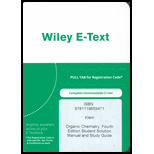
ORGANIC CHEMISTRY,SOLN.MAN.+...-ACCESS
4th Edition
ISBN: 9781119659471
Author: Klein
Publisher: WILEY
expand_more
expand_more
format_list_bulleted
Concept explainers
Question
Chapter 12, Problem 52PP
Interpretation Introduction
Interpretation:
The mechanism and possible product formed with the given reaction is to be determined. The use of a proton source is to be explained.
Concept introduction:
In this reaction, the addition of Grignard reagent would take place. The Grignard reagent (methyl magnesium bromide) functions as a nucleophile and attacks the electrophilic carbon atom of the ester carbonyl. The resulting formation of a
Expert Solution & Answer
Want to see the full answer?
Check out a sample textbook solution
Students have asked these similar questions
For the titration of a divalent metal ion (M2+) with EDTA, the stoichiometry of the reaction is typically:
1:1 (one mole of EDTA per mole of metal ion)
2:1 (two moles of EDTA per mole of metal ion)
1:2 (one mole of EDTA per two moles of metal ion)
None of the above
Please help me solve this reaction.
Indicate the products obtained by mixing 2,2-dimethylpropanal with acetaldehyde and sodium ethoxide in ethanol.
Chapter 12 Solutions
ORGANIC CHEMISTRY,SOLN.MAN.+...-ACCESS
Ch. 12.1 - Prob. 1LTSCh. 12.1 - Prob. 1PTSCh. 12.1 - Prob. 2ATSCh. 12.1 - Prob. 3CCCh. 12.2 - Prob. 4CCCh. 12.3 - Prob. 8CCCh. 12.3 - Prob. 9CCCh. 12.4 - Prob. 3LTSCh. 12.4 - Prob. 10PTSCh. 12.4 - Prob. 11ATS
Ch. 12.4 - Prob. 4LTSCh. 12.4 - Prob. 12PTSCh. 12.4 - Prob. 13ATSCh. 12.6 - Prob. 14CCCh. 12.6 - Prob. 5LTSCh. 12.6 - Prob. 15PTSCh. 12.6 - Prob. 16PTSCh. 12.7 - Prob. 18CCCh. 12.9 - Prob. 6LTSCh. 12.9 - Prob. 19PTSCh. 12.9 - Prob. 20ATSCh. 12.9 - Prob. 21CCCh. 12.10 - Prob. 7LTSCh. 12.10 - Prob. 22PTSCh. 12.10 - Prob. 23ATSCh. 12.13 - Prob. 8LTSCh. 12.13 - Prob. 24PTSCh. 12.13 - Prob. 25ATSCh. 12.13 - Prob. 26CCCh. 12.13 - Prob. 9LTSCh. 12.13 - Prob. 27PTSCh. 12.13 - Prob. 28ATSCh. 12 - Prob. 29PPCh. 12 - Prob. 30PPCh. 12 - Prob. 31PPCh. 12 - Prob. 32PPCh. 12 - Prob. 33PPCh. 12 - Prob. 34PPCh. 12 - Prob. 35PPCh. 12 - Prob. 36PPCh. 12 - Prob. 37PPCh. 12 - Prob. 38PPCh. 12 - Prob. 39PPCh. 12 - Prob. 40PPCh. 12 - Prob. 41PPCh. 12 - Prob. 42PPCh. 12 - Prob. 43PPCh. 12 - Prob. 44PPCh. 12 - Prob. 45PPCh. 12 - Prob. 46PPCh. 12 - Prob. 47PPCh. 12 - Prob. 48PPCh. 12 - Prob. 49PPCh. 12 - Prob. 50PPCh. 12 - Prob. 51PPCh. 12 - Prob. 52PPCh. 12 - Prob. 53ASPCh. 12 - Prob. 54ASPCh. 12 - Prob. 55ASPCh. 12 - Prob. 62IPCh. 12 - Prob. 64IPCh. 12 - Prob. 65IPCh. 12 - Prob. 66IPCh. 12 - Prob. 67IPCh. 12 - Prob. 68IPCh. 12 - Prob. 69IPCh. 12 - Prob. 74IP
Knowledge Booster
Learn more about
Need a deep-dive on the concept behind this application? Look no further. Learn more about this topic, chemistry and related others by exploring similar questions and additional content below.Similar questions
- Synthesize 2-Ethyl-3-methyloxirane from dimethyl(propyl)sulfonium iodide using the necessary organic or inorganic reagents. Draw the structures of the compounds.arrow_forwardSynthesize 2-Hydroxy-2-phenylacetonitrile from phenylmethanol using the necessary organic or inorganic reagents. Draw the structures of the compounds.arrow_forwardSynthesize N-Methylcyclohexylamine from cyclohexanol using the necessary organic or inorganic reagents. Draw the structures of the compounds.arrow_forward
- Synthesize N-Methylcyclohexylamine from cyclohexanol using the necessary organic or inorganic reagents. Draw the structures of the compounds.arrow_forwardIf possible, please provide the formula of the compound 3,3-dimethylbut-2-enal.arrow_forwardSynthesize 1,4-dibromobenzene from acetanilide (N-phenylacetamide) using the necessary organic or inorganic reagents. Draw the structures of the compounds.arrow_forward
- Indicate the products obtained by mixing (3-oxo-3-phenylpropyl)triphenylphosphonium bromide with sodium hydride.arrow_forwardWe mix N-ethyl-2-hexanamine with excess methyl iodide and followed by heating with aqueous Ag2O. Indicate the major products obtained.arrow_forwardIndicate the products obtained by mixing acetophenone with iodine and NaOH.arrow_forward
- Indicate the products obtained by mixing 2-Propanone and ethyllithium and performing a subsequent acid hydrolysis.arrow_forwardIndicate the products obtained if (E)-2-butenal and 3-oxo-butanenitrile are mixed with sodium ethoxide in ethanol.arrow_forwardQuestion 3 (4 points), Draw a full arrow-pushing mechanism for the following reaction Please draw all structures clearly. Note that this intramolecular cyclization is analogous to the mechanism for halohydrin formation. COH Br + HBr Brarrow_forward
arrow_back_ios
SEE MORE QUESTIONS
arrow_forward_ios
Recommended textbooks for you
 Organic ChemistryChemistryISBN:9781305580350Author:William H. Brown, Brent L. Iverson, Eric Anslyn, Christopher S. FootePublisher:Cengage Learning
Organic ChemistryChemistryISBN:9781305580350Author:William H. Brown, Brent L. Iverson, Eric Anslyn, Christopher S. FootePublisher:Cengage Learning

Organic Chemistry
Chemistry
ISBN:9781305580350
Author:William H. Brown, Brent L. Iverson, Eric Anslyn, Christopher S. Foote
Publisher:Cengage Learning

Coenzymes and cofactors; Author: CH15 SWAYAM Prabha IIT Madras;https://www.youtube.com/watch?v=bubY2Nm7hVM;License: Standard YouTube License, CC-BY
Aromaticity and Huckel's Rule; Author: Professor Dave Explains;https://www.youtube.com/watch?v=7-BguH4_WBQ;License: Standard Youtube License